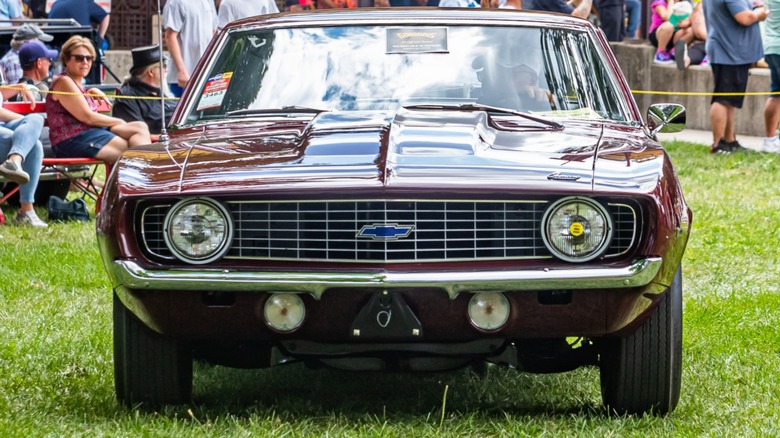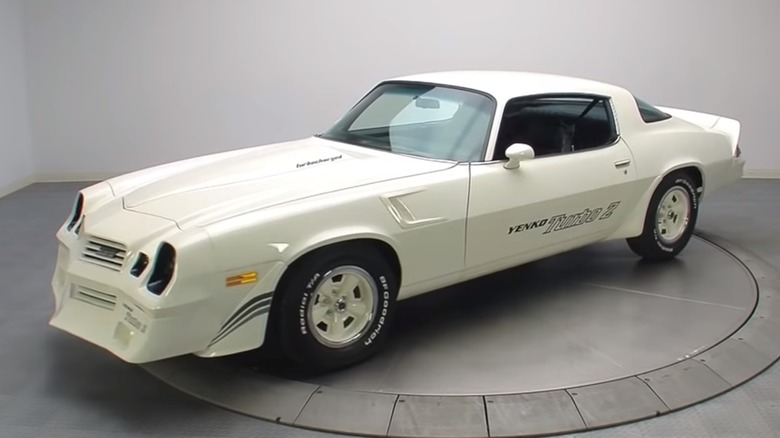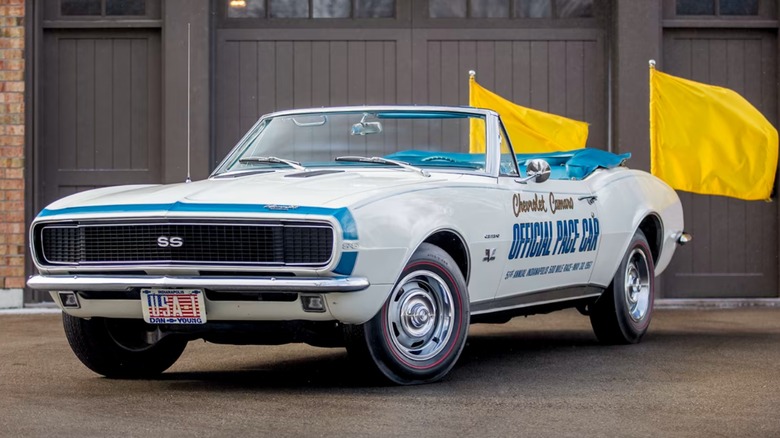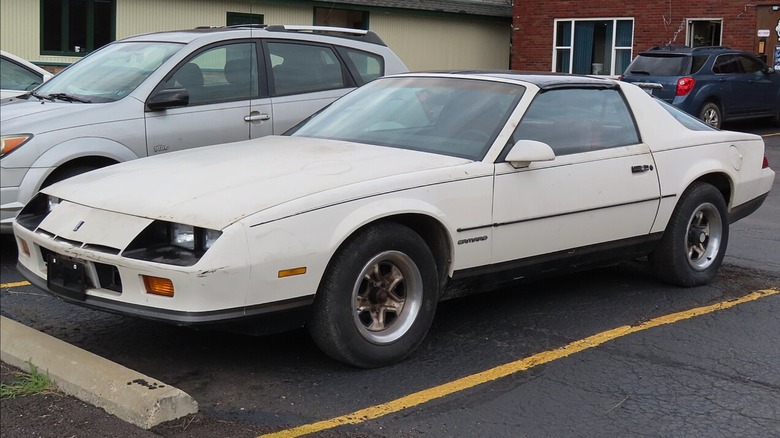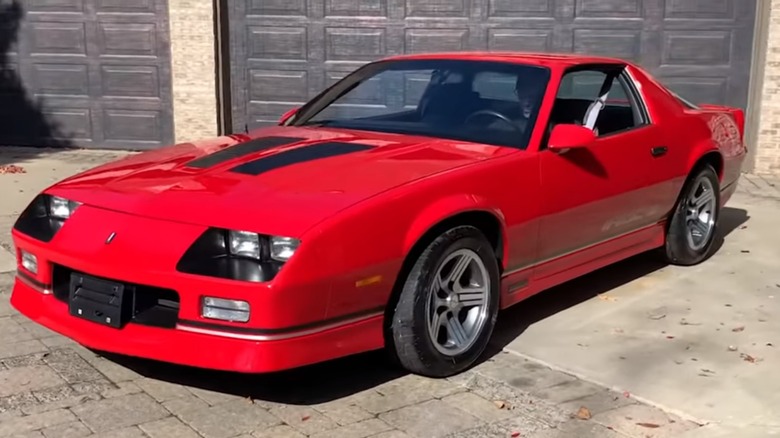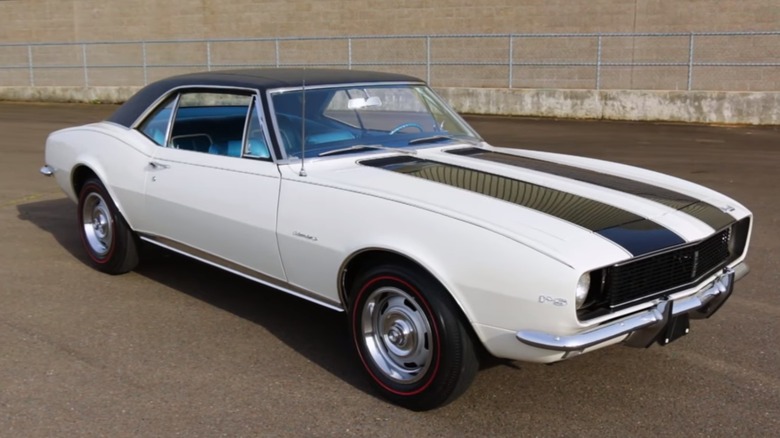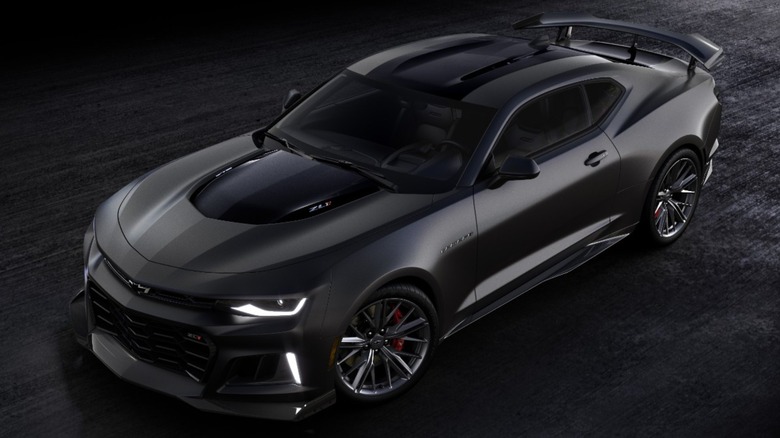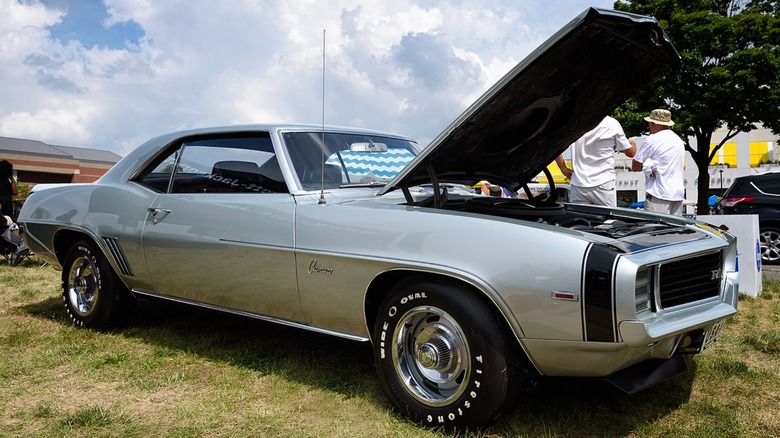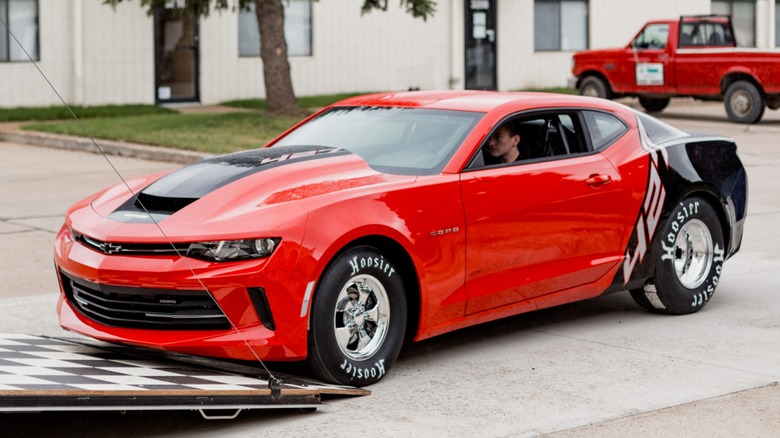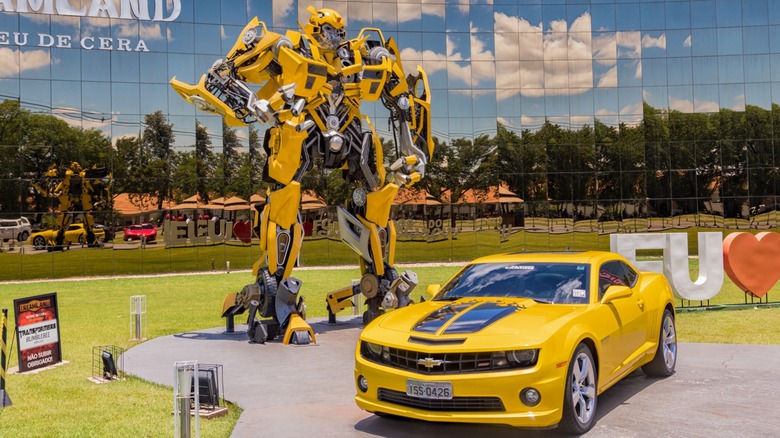10 Super Rare Camaro Models You Might Never See In Person
Chevrolet may have been a bit behind the curve when it introduced its first pony car, but it showed up with what would become one of its most iconic and enduring models in 1967 — the Chevrolet Camaro. It gained instant popularity, receiving accolades from the motoring press along with buyers' approval in the form of excellent sales numbers. From the start, Chevrolet offered special editions and custom options packages to cater the car to every buyer's taste, including many meant to go from the factory directly to the racetrack.
The first generation of Camaro was a big hit, and subsequent generations managed to keep the excitement level high. Chevrolet kept it in production through the decades (with a hiatus from 2002 to 2010). It has again been announced that the Camaro will be discontinued following the 2024 model year, although that announcement came after production of many recent limited-edition vehicles. Some of these custom Camaros, both new and old, are relatively widespread, while others can be scarce, often making them extremely valuable. Despite the potentially high value of limited-production cars, unless you have the funds to buy one yourself, seeing them is not likely to happen. Some of the rarest Camaros are also the most special, but these examples you are not likely to see yourself any time soon.
1981 Chevrolet Camaro Yenko Turbo Z
The Yenko name has been attached to Chevrolet models since Don Yenko, a Chevy dealer, started modifying Corvairs and selling them as track-ready cars in the '60s. He then moved on to modifying Camaros and found success with them as well. The custom car business dwindled in the early '70s as the muscle car era headed toward a close. However, one last hurrah came emblazoned with the Yenko name before he quit the business for good, the 1981 Chevrolet Camaro Yenko Turbo Z.
In 1981, Chevrolet no longer offered special high-performance engines from the Central Order Processing Office (COPO), which Yenko had used in the past. Therefore, he took a standard Z/28 model equipped with the LM-1 350 V8, which came with a paltry output of just 175 horsepower, and added forced induction. Installing a Turbo International turbocharging system on the anemic 350 with Stage One and Stage Two packages available, the power output was increased to an estimated 240 to 250, although it was never officially measured. With the original carburetor in use, a water injection system was also added to prevent ignition problems inherent to turbo cars without computer controls. This and a fuel heater helped ensure the cars remained 50-state compliant.
Yenko only produced 19 of these cars, of which only three were Stage Two cars, including a stiffer suspension, Kamp leather seats, and Weld two-piece wheels. With so few cars in the world, you'll likely only see one at a car show, and only if you are extremely lucky.
1967 Chevrolet Camaro RS/SS Pace Car
When the Camaro launched in 1967, it could be ordered in one of several trims, including Z/28, RS, and SS. The SS package provided the biggest and most powerful engine — it was an upgrade to the RS trim — and SS cars today are usually highly prized by collectors. More collectible still are convertible models, which were often ordered in much smaller numbers. But there is another way to get a 1967 Camaro made in even fewer numbers: buy a Pace Car.
The Chevrolet Camaro was chosen to be the Official Pace Car for the 51st Indianapolis 500 Mile Race. This is a tradition that GM has long been involved with and Camaro has been chosen as Pace Cars many times over the years. They came with light blue interiors, and decals on the doors read, "Chevrolet Camaro Official Pace Car 51st Annual Indianapolis 500 Mile Race — May 30, 1967." These cars were produced in limited numbers, with at least 81 going to the racing organization for promotional purposes and an undetermined number sold through dealers to insiders who knew when and how to order one. Estimates are that only a couple hundred cars were made in all. Some came with the 396 and others a 350. The details are a bit murky.
With only a couple hundred cars in total, you may see one at a museum or a car show once in a while. But with units selling for prices up to $632,500 (such as one did at Mecum in 2022), it is doubtful they will be found on the streets.
1982-1986 Chevrolet Iron Duke Camaro
When the updated Camaro launched with the 1982 model year, it introduced a radical design departure from the outgoing model. The rounded curves had been replaced with sharp creases and flat surfaces, while the near-useless small trunk had been swapped for a convenient, practical rear hatch with a large greenhouse. Furthermore, the chassis had seen many improvements, including losing the rear leaf springs in favor of coils and an updated front suspension with modern struts. The new car handled much better than the old and its styling looked like the best of what the 1980s had to offer.
While the '80s brought promise to the Camaro, it failed to include much power. Detroit was still trying to figure out how to make cars powerful and clean-burning at the same time. Therefore, Chevrolet had to release its all-new sports car with the best it had available, which meant even the top-performing Z/28 didn't exceed 165 horsepower. Things were tough all over, but a base model Camaro at the time was almost pointless.
The base model Camaro was slow and uninspiring due to its 2.4-liter, 4-cylinder engine, affectionately known as the Iron Duke. With a quarter-mile time of nearly 20 seconds, it was more frustrating than fun. Out of 189,747 Camaros sold in 1982, only 21,802 had the Iron Duke. With the V6 model being only $125 extra, it was an easy choice. But this is why the Iron Duke Camaro is rare. Relatively few were sold back then and even fewer have been preserved until today. There is not much of a collector market for vintage 90-horsepower Camaros, meaning most of them rusted away long ago.
[Featured image by MercurySable99 via Wikimedia Commons | Cropped and scaled | CC BY-SA 4.0]
1988-1992 Chevrolet Camaro 1LE
Available when ordering a Camaro IROC-Z model from 1988 to 1990 or the Z/28 from 1991-1992, the 1LE package turned what was already a pretty good car with competitive power into something you could have a lot of fun with. The top-performing available V8 engines included the fuel-injected LB9 305 or B2L 350. But for those who knew, a special order could transform the car into a track day superstar.
With proof of participation in professional auto racing, one could order a new IROC-Z or Z/28 with a special list of upgrades. You first had to order your car with one of the optional V8 engines. Then, option code G92 added the Performance Rear Axle kit, and G80 added Positraction. The trick needed to complete the package was to also delete air conditioning from the order and this triggered the rest of the 1LE package. This gave your car larger brakes, a baffled gas tank, a close-ratio transmission with a shorter fifth gear, stiffer struts and springs, an aluminum driveshaft, and more. This made a car ready for the race track from day one.
Initially, only 62 cars were built this way. But by 1992, 1,360 1LE Camaros had left the factory. Not only were they the best handling and performing of the third-gen Camaros, they are now also the rarest. Seeing one will also be tricky: They look like any other IROC-Z or Z/28, so even if you have seen one in person, you may not know it.
1967 Chevrolet Camaro Z/28
For most of the past 57 years, the Z/28 label has been affixed to some of the hottest and most desirable Chevrolet vehicles ever. Even in the days when emissions technology choked the power out of new cars, the Z/28 was still special, and anyone who drove one knew it. While other car models usually have different trim levels (with GT denoting the highest performance version), Chevrolet went another way with its Camaro, deriving the Z/28 moniker from a surprisingly mundane source.
In 1967, Chevrolet manager Pete Estes wanted a version of the new Camaro to be built to compete in the SCCA Trans Am series, which had a maximum displacement of 5.0 liters. Estes had engineers take a crankshaft from the 283 and install it in the 327, resulting in a displacement of 302. Several other upgrades to the engine and suspension went into a build sheet for ordering. The high-performance SS order code had been Z27, so the new car code was Z28. Instead of coming up with a new name for the car, it was simply called the Z/28 package, and the name has stuck ever since.
The first-year model Camaro offered the Z/28 as a special package meant for racing. This resulted in relatively few being built, with production for the year ending at just 602 copies. 1967 models are now hard to come by and remain extremely valuable and rarely seen outside of high-priced auctions.
2024 Chevrolet Camaro Collector's Edition
For the sixth and final generation of Chevrolet Camaro, trim levels have come with more special editions than ever, such as the 50th anniversary 2017 Camaro. For its final year of production, the Camaro Collector's Edition will be offered and includes several exclusive features sure to make it stand out.
The limited-production Collector's Edition starts with the top-line ZL1 trim package that provides the 650-horsepower supercharged 6.2-liter V8 cooled by a series of 11 heat exchangers and is stopped by six-piston Brembo brakes. It rolls on 20-inch black satin wheels with polished forged version optional, and downforce is provided by the 1LE's front splitter and the ZL1 rear splitter. Performance is already at the limit with the ZL1 package, making the Collector's Edition a styling upgrade that makes for a sinister-looking Camaro.
While the Collector's Edition package is available for LT/RS, LT1, and SS trims, only the ZL1 will receive Panther Black Matte paint with Metallic Black ZL1 Stripe with red brake calipers and black lug nuts. Production of ZL1 cars is limited to just 350 copies. All cars will receive a serial-numbered steering wheel badge, custom floor mats with laser etching, and front fender panther graphics. Furthermore, the lucky 350 buyers will also receive a bespoke Canfield Sport 45mm watch from Shinola. With so few produced, priced at $14,999 over the cost of the ZL1, don't expect to see them any time soon, unless you happen to be accepting delivery of one at the dealership yourself.
1970 Chevrolet Camaro SS
Chevrolet introduced a brand-new Camaro that was wildly different from its predecessor in 1970. Its shape was more aggressive and curvier, but it also included many upgrades to the chassis, providing improved handling. The Z/28 of that year was the top performance model and came with a 350 V8 making 360 horsepower. Those who chose the SS model received a 350 V8 making just 300 horsepower. However, the SS could also be ordered with the big block L78 396 V8, which increased output to 375 horsepower, beating the Z/28's 350 horsepower and with a huge helping of torque. As torque is what makes a car accelerate, the SS396 would make for a great choice for drag racing.
All of the 1970 model Camaros are cool cars with great looks. The split front bumper and round quad taillights make it distinctive, while the driver-focused dashboard elicits feelings of being in a cockpit, especially with the shifter reminiscent of the throttle of an airplane. Chevrolet sold tens of thousands of these cars in 1970, so seeing them is not rare, although fewer of them are on the streets these days. And while the Z/28 is always the desirable model, only 600 buyers picked the L78 396 V8, a $395 option, making them a rare sight today.
1969 Chevrolet Camaro ZL1
Chevrolet's powerhouse Camaro of the last few years has been its ZL1 model, but that name has a heritage dating back to the '60s. Like the Z/28, the ZL1 package gets its name from the original order code used to build the cars at the factory. However, unlike the Z/28, the ZL1 was never an official production model from Chevrolet until recently.
In the '60s, it was common for dealers to order cars from the factory equipped with certain high-performance parts designed for use on the race track. In the era before emissions regulations, nothing prevented Chevrolet from selling these components on cars meant to be driven on the street. Furthermore, Chevrolet developed and built engines, transmissions, and suspension components for race cars that were bought by racing teams around the country. A Kansas City dealer was so impressed with the all-aluminum big-block engines used in Can Am series racing that he devised a plan to order some brand-new Camaros equipped with these special engines (rated at 430 horsepower).
Fifty cars were ordered, but a snafu in the cost of the cars led to some of the cars being returned to Chevrolet and then being sold slowly by others through 1973 at a cost that was $1,000 higher (in 1973 dollars) than the most expensive Corvette of the day. No more cars like this were made, as the price was too high for a street car. They have since become legendary, and the high initial price would have been an excellent investment as they are worth a fortune today.
Chevrolet COPO Camaro
The 1969 Camaro ZL1 is the original COPO Camaro, although it was not an officially sanctioned vehicle build and did not continue after the first initial order. Other racing spec vehicles have been offered by Chevrolet over the years in small numbers, but for the 2012 model year, Chevrolet used the COPO name and made it official with a series of low-volume high-power racing cars.
The 2012 COPO Camaro could be ordered with a choice of three V8 engines, with outputs ranging from a whole lot of power to an enormously excessive amount of power. The engines conformed to NHRA rules and come in sizes of 5.3 or 7.0 liters, with the former having either a supercharger or blower installed. Only 69 of these were built in 2012 and the tradition has continued until the final 2024 model. By 2023, Chevrolet had increased its offerings by offering a 10.3-liter V8 with an output of 1,004 horsepower. They also offered this on its own as a crate engine for the completely reasonable price of $37,758. These cars are built for NHRA Stock Eliminator and Super Stock classes and come fully equipped for racing, devoid of any creature comforts you might expect from a Camaro at your local dealer.
2012 Chevrolet Camaro Transformers Edition
Cars and movies have been intertwined for as long as the two have existed. Sometimes the car is as much a star as any actor, such as in the movie "Smokey and the Bandit." With modern CGI animation, cars have become lead characters themselves, as they did in the reboot of "Transformers" in 2007.
A 1976 Camaro is used early in the film before being revealed as a Transformer that later changes into an updated model. Chevrolet involved itself heavily in this movie, using it as a marketing tool for its new Camaro, which would not be officially released for another two years after the film. The film was a success that spawned several successive films and turned the 1980s Saturday cartoon into a Hollywood blockbuster franchise. It also helped launch the new Camaro, ensuring its success.
Capitalizing on the phenomenon, Chevrolet released an official production car in the colors of the movie car for the 2012 model year. The bright Rally Yellow Camaro featured the same black racing stripes as in the movie, with black leather interior and yellow highlight stitching. It also had HID headlights, 20-inch black-painted wheels, a bespoke spoiler, and "Autobot" logos on the fenders and center caps. Options were a black ground effects package or 21-inch wheels. The Transformers package cost an additional $3,000, and only 1,411 buyers opted to purchase one. Unlikely as it may, if you see one, remember it's "more than meets the eye."
